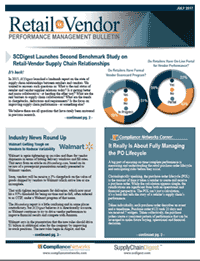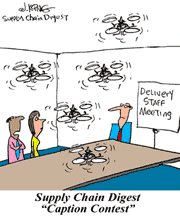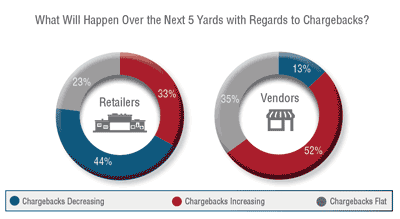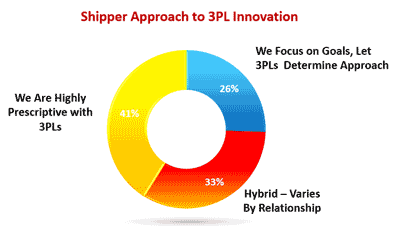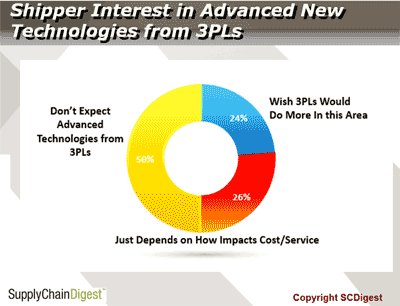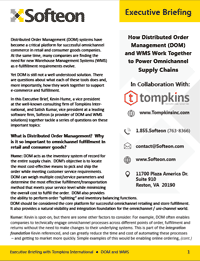 |
August 3, 2017 - Supply Chain Flagship Newsletter |
 |
| FEATURED NEW JULY BULLETIN |
|||
| The Retail Vendor Performance Management Bulletin |
|||
• Compliance Networks Corner: It Really is All about the PO Lifecycle
• Walmart Getting Tough on Vendors to Reduce Variability
• Another Factor in Retail Sales Woes • Amazon Is Buying Products from Some US Brands at Full Price To Build Global Inventory |
|||
 |
|
||||||||||||||||||||||||||||||||||||||||||||||||||||||||||||||||||||||||||||||||||||||||||||||||||||||||||||||||||||
|
|||||||||||||||||||||||||||||||||||||||||||||||||||||||||||||||||||||||||||||||||||||||||||||||||||||||||||||||||||||
"Although we're 14 months into our relationship, I find that, many times, I have to lead the 3PL horse to water - AND make him drink," one shipper wittily commented relative to 3PL innovation capabilities. Another noted that "We really need 3PLs to innovate on technology to lower the transactional cost of fulfillment activities." All that said, 3PLs can only innovate, obviously, in relationships that are supportive of them doing so. The would it seem most likely to be in gainsharing or the even more advanced "vested outsourcing" types of relationships, and as I reported last time I was surprise at the very small percentages of these types of arrangements that are currently being used. On a similar vein, 41% of shippers say they are highly prescriptive with 3PLs - in other words, "just do what we tell you," with 26% of shippers saying they welcome 3PL innovation and 33% saying it varies by specific relationship (see chart below). |
|||||||||||||||||||||||||||||||||||||||||||||||||||||||||||||||||||||||||||||||||||||||||||||||||||||||||||||||||||||
One shipper commented that "We want them [3PLs] to learn and understand our business; then we seek out suggestions to improve and innovate." One 3PL respondent was very positive on this topic, commenting that "Client relationships vary greatly, but the trend is for more collaborative relationships in both procurement and supply chain strategy." An interesting question on this innovation topic is what should be the role of 3PLs in bringing emerging technologies (robotics, drones, IoT, 3D printing, etc.) to the market. This is actually a more interesting and nuanced issue than some may consider, and is not un-related to the relative lack of 3PL use of automated distribution facilities. Why is that the case? Because the contacts with shippers are generally not long enough to ensure a payback from that investment in materials handling systems. And in general, 3PLs are not much interested with bringing costly new technologies to market without a client that has committed to paying for it. But given the trends of a growing percent of logistics being outsourced and the need for innovation, doesn't that status quo have to change? Should shipper-3PL contracts really be the barrier to more robotics in the DC? As shown in the chart below, 50% of shippers do not see 3PLs as a driver of advanced technology adoption, versus just under a quarter who would like to see 3PLs do more in this area, and 26% who say it just depends on whether it will impact cost or service. |
|||||||||||||||||||||||||||||||||||||||||||||||||||||||||||||||||||||||||||||||||||||||||||||||||||||||||||||||||||||
I will note there are some signs of change going on, notably the investment DHL has been making in things like augmented reality via smart glasses and use of robots in the DC. There is a lot more, but think I will end it here. Overall, I think we need a new model that better encourages 3PL innovation, which means evolving the nature of contracts - but I am not optimistic that will happen any time soon. I also believe 3PLs themselves must put more dollars in an innovation budget. What are your thoughts on innovation between shippers and 3PLs? Are contracts a major issue? What needs to change? Let us know your thoughts at the Feedback button below. |
|||||||||||||||||||||||||||||||||||||||||||||||||||||||||||||||||||||||||||||||||||||||||||||||||||||||||||||||||||||
|
|||||||||||||||||||||||||||||||||||||||||||||||||||||||||||||||||||||||||||||||||||||||||||||||||||||||||||||||||||||
|
|||||||||||||||||||||||||||||||||||||||||||||||||||||||||||||||||||||||||||||||||||||||||||||||||||||||||||||||||||||
|
|
|
YOUR FEEDBACK
We received a number of emails on our piece on a consultant saying Walmart has been pressuring carriers not to also haul freight for rival Amazon - after the Wall Street Journal reported Walmart would not let its software vendors use Amazon's popular web services platform for their systems. Walmart strongly denied the news relative to the carrier pressure.
A sampling of Feedback below, some from our partner RetailWire, which carried our article.
Feedback on Walmart on Carriers and Software Vendors not to Use Amazon
![]()
Walmart likes to exert influence. This should surprise no one that they would try to use their influence on their transportation providers. It’s a slippery slope and hopefully it truly is a false report or Walmart will ultimately suffer the consequences for this.
On the other hand, with respect to AWS — the real question is, why do ANY retailers support using AWS directly or indirectly through their technology suppliers? Why feed the beast its most profitable business?
Ricardo Belmar
Sr Director, Worldwide Enterprise Product Marketing
InfoVista

![]()
Walmart put the trucking issue to bed with a denial and an admission that doing so would be illegal. They would lose badly in attempting such a scheme.
The more interesting issue is AWS. Data sensitivity is a bonafide concern, and Walmart’s move can encourage other retailers to follow suit with their technology vendors.
I hope Microsoft Azure is listening, as they can grab business with value
-added solutions for retailers, such as customer history machine learning for better service and recommendations, better kiosk and tablet support for associates, and less time maintaining servers than AWS requires.
Dan Frechtling
SVP Product and Marketing
G2 Web Services

![]()
Amazon Web Services and the issue of carrier limits when working with Amazon are two completely different issues.
There are many reasons why Walmart and other businesses should be extremely cautious about having their sensitive, competitive data residing on AWS cloud servers.
The business of hauling freight is an independent contractor decision that does not involve sensitive data or security. Walmart has the volume and resources to compete for carrier space. It is the smaller retailer who will be squeezed out during peak holiday seasons.
Chris Petersen
President
Integrated Marketing Solutions

SUPPLY CHAIN TRIVIA ANSWER
Q: What is the percent of US freight transportation spent on trucking (including private fleets but excluding parcel)?
A: 66.6% in 2016, according to the State of Logistics Report released in June.
| © SupplyChainDigest™ 2003-2017. All Rights Reserved. SupplyChainDigest PO Box 714 Springboro, Ohio 45066 |
POWERED BY: XDIMENSION
|
